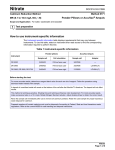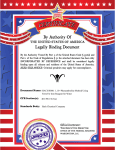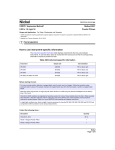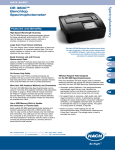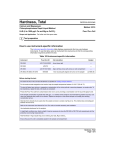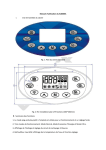Download Nitrate - Camlab
Transcript
Nitrate, HR, 8039 Nitrate DOC316.53.01066 Cadmium Reduction Method Method 8039 HR (0.3 to 30.0 mg/L NO3––N) Powder Pillow or AccuVac® Ampuls Scope and Application: For water, wastewater and seawater Test preparation How to use instrument-specific information The Instrument-specific information table displays requirements that may vary between instruments. To use this table, select an instrument then read across to find the corresponding information required to perform this test. Table 1 Instrument-specific information Powder pillows AccuVac Ampuls Instrument Sample cell Cell orientation Sample cell Adapter DR 5000 2495402 Fill line faces user 2427606 — DR 3900 2495402 Fill line faces user 2427606 LZV846 (A) DR 3800, DR 2800, DR 2700 2495402 Fill line faces right 2122800 LZV584 (C) Before starting the test: For more accurate results, determine a reagent blank value for each new lot of reagent. Follow the procedure using deionized water instead of the sample. Subtract the reagent blank value from the final results or perform a reagent blank adjust. A deposit of unoxidized metal will remain at the bottom of the cell after the NitraVer® 5 dissolves. The deposit will not affect results. This method is technique-sensitive. Shaking time and technique influence color development. For most accurate results, make successive tests on a 10-mg/L Nitrate Nitrogen Standard solution. Adjust shaking time and technique to obtain the correct result. Use this technique for all the samples. Rinse the sample cell immediately after use to remove all cadmium particles. Prepared samples will contain cadmium and must be disposed of according to federal, state and local hazardous waste regulations. Refer to the current MSDS for safe handling and disposal instructions. Nitrate Page 1 of 10 Nitrate Collect the following items: Description Quantity Powder Pillow Test: NitraVer® 5 Nitrate Reagent Powder Pillow 1 Sample Cells, 1-inch, 10-mL, with stopper 2 AccuVac Test: NitraVer® 5 Nitrate Reagent AccuVac® Ampul 1 Beaker, 50-mL 1 Sample Cell, for blank 1 See Consumables and replacement items for reorder information. Cadmium Reduction Method for powder pillows CAUTION Hazardous waste exposure. Prepared samples contain cadmium. Refer to the current MSDS for safe handling and disposal instructions. Follow all federal, state and local hazardous waste disposal regulations. Stored Programs 355 N, Nitrate HR PP Start 1. Select the test. Insert an adapter if required (see Instrumentspecific information). Refer to the user manual for orientation. Nitrate Page 2 of 10 2. Fill a sample cell with 10 mL of sample. 3. Prepared Sample: Add the contents of one NitraVer 5 Nitrate Reagent Powder Pillow. Stopper. 4. Start the instrument timer. A one-minute reaction time will begin. Nitrate Cadmium Reduction Method for powder pillows (continued) CAUTION Hazardous waste exposure. Prepared samples contain cadmium. Refer to the current MSDS for safe handling and disposal instructions. Follow all federal, state and local hazardous waste disposal regulations. 5. Shake the cell vigorously until the timer expires. Note: Some solid materials may not dissolve. 6. When the timer expires, start the timer again. A five-minute reaction period will begin. The display will show: 0.0 mg/L NO3––N 8. Wipe the blank and insert it into the cell holder. An amber color will develop if nitrate is present. Zero 9. ZERO the instrument. 7. Blank Preparation: When the timer expires, fill a second sample cell with 10 mL of sample. Read 10. Within one minute after the timer expires, wipe the prepared sample and insert it into the cell holder. 11. READ the results in mg/L NO3––N. To display other chemical forms, refer to the user manual. Nitrate Page 3 of 10 Nitrate Cadmium Reduction Method for AccuVac® Ampuls CAUTION Hazardous waste exposure. Prepared samples contain cadmium. Refer to the current MSDS for safe handling and disposal instructions. Follow all federal, state and local hazardous waste disposal regulations. Stored Programs 361 N, Nitrate HR AV Start 1. Select the test. Insert an adapter if required (see Instrumentspecific information). 2. Prepared Sample: Collect at least 40 mL of sample in a 50-mL beaker. 3. Tap the bottom of a NitraVer 5 Nitrate AccuVac® Ampul on a hard surface to dislodge powder. Fill the Ampul with sample. Keep the tip immersed while the Ampul fills completely. Insert a cap over the Ampul tip. 6. When the timer expires, start the timer again. A five-minute reaction period will begin. Do not agitate or disturb the sample during this time. 7. Blank Preparation: When the timer expires, fill a round sample cell with 10 mL of sample. Refer to the user manual for orientation. 5. Invert the Ampul 48–52 times as the timer counts down. An amber color will develop if nitrate is present. Nitrate Page 4 of 10 4. Start the instrument timer. A one-minute reaction period will begin. 8. Wipe the blank and insert it into the cell holder. Nitrate Cadmium Reduction Method for AccuVac® Ampuls (continued) CAUTION Hazardous waste exposure. Prepared samples contain cadmium. Refer to the current MSDS for safe handling and disposal instructions. Follow all federal, state and local hazardous waste disposal regulations. Zero 9. ZERO the instrument. The display will show: 0.0 mg/L NO3––N Read 10. Within one minute after the timer expires, wipe the Ampul and insert into the cell holder. 11. READ the results in mg/L NO3––N. Interferences Table 2 Interfering substances 1 Interfering substance Interference level Chloride Chloride concentrations above 100 mg/L will cause low results. The test may be used at high chloride concentrations (seawater), but a calibration must be done using standards spiked to the same chloride concentration. Refer to Seawater calibration. Ferric iron Interferes at all levels Nitrite Interferes at all levels Compensate for nitrite interference as follows: Before performing step 3, add 30-g/L Bromine Water1 dropwise to the sample until a yellow color remains. Add one drop of 30-g/L Phenol Solution1 to destroy the color. Proceed with step 3. Report the results as total nitrate and nitrite. pH Highly buffered samples or extreme sample pH may exceed the buffering capacity of the reagents and require sample pretreatment. Strong oxidizing and reducing substances Interfere at all levels See Optional reagents and apparatus. Nitrate Page 5 of 10 Nitrate Seawater calibration Chloride concentrations above 100 mg/L will cause low results. To perform this test in water with high interference level, calibrate the water using standards spiked to the same chloride concentrations as the required samples. To prepare calibration standards containing 5.0, 10.0, 20.0 and 30.0 mg/L nitrate as NO3––N: 1. Prepare a 1 L volume of chloride water that matches the concentration of the samples, using the following equation: a. Add necessary Chloride concentration (g/L) x (1.6485) = g of ACS grade NaCl to 1 L of deionized water. 18.8 g/L is a typical seawater chloride concentration. b. Mix this solution thoroughly to get a homogeneous solution. Use this water as the dilution water instead of the deionized water when preparing the nitrate standards. 2. Use Class A glassware or a Tensette Pipet to pipet 0.5, 1.0, 2.0, and 3.0 mL of the 1000 mg/L Nitrogen-Nitrate as NO3––N (NIST) Standard Solution (Catalog Number 1279249) into four different 100 mL Class A volumetric flasks. 3. Dilute to the mark with the prepared chloride water. Mix thoroughly. 4. Use the prepared chloride water for the 0-mg/L nitrate as NO3––N standard. Sample collection, preservation and storage • More reliable results are obtained when samples are analyzed as soon as possible after collection. If prompt analysis is impossible, store samples in clean plastic or glass bottles for up to 24 hours at 4 °C. To preserve samples for longer periods, add 2 mL of Concentrated Sulfuric Acid (H2SO4)* per liter and store at 4 °C. The results are reported as total nitrate plus nitrite. • Before analysis, warm the sample to room temperature and adjust the pH to 7 with 5.0 N Sodium Hydroxide Standard Solution*. Do not use mercury compounds as preservatives. • Correct the test result for volume additions by dividing the total volume (acid + base + sample) by the original sample volume and multiplying the test result by this factor. Accuracy check Standard additions method for powder pillows (sample spike) Required for accuracy check: • Nitrate Nitrogen Standard solution, 1000-mg/L NO3––N • Mixing cylinders • 25-mL Volumetric pipet • TenSette Pipet and Pipet Tips • Pipet filler • 100 mL Volumetric Flask 1. Prepare a 250-mL nitrate nitrogen standard solution by pipetting 25 mL of a 1000 mg/L Nitrate Nitrogen standard solution into a 100 mL volumetric flask. Dilute the solution to the required volume with deionized water and mix thoroughly. 2. After reading test results, leave the sample cell (unspiked sample) in the instrument. 3. Select Options>More>Standard Additions from the instrument menu. * See Optional reagents and apparatus. Nitrate Page 6 of 10 Nitrate 4. Accept the default values for standard concentration, sample volume and spike volumes. After the values are accepted, the unspiked sample reading will appear in the top row. See the user manual for more information. 5. Use the TenSette Pipet to prepare spiked samples: add 0.1 mL, 0.2 mL and 0.3 mL of standard to three 10-mL portions of fresh sample. 6. Follow the Cadmium Reduction Method for powder pillows test procedure for each of the spiked samples using the powder pillows, starting with the 0.1 mL sample spike. Measure each of the spiked samples in the instrument. 7. Select GRAPH to view the results. Select IDEAL LINE (or best-fit) to compare the standard addition results to the theoretical 100% recovery. Standard additions method for AccuVac Ampuls (sample spike) 1. Fill three mixing cylinders each with 50-mL of sample and spike with 0.4 mL, 0.8 mL and 1.2 mL of 250-mg/L standard. 2. Transfer 40 mL from each of the three mixing cylinders to three 50-mL beakers. 3. Analyze each standard addition sample as described in the Cadmium Reduction Method for AccuVac® Ampuls. 4. Accept each standard additions reading. Each addition should reflect approximately 100% recovery. Standard solution method Note: Refer to the instrument user manual for specific software navigation instructions. Required for accuracy check: • 10.0-mg/L Nitrate Nitrogen Standard Solution 1. Use the 10.0-mg/L Nitrate Nitrogen Standard Solution in place of the sample. Follow the Cadmium Reduction Method for powder pillows and Cadmium Reduction Method for AccuVac® Ampuls test procedures. 2. To adjust the calibration curve using the reading obtained with the standard solution, select Options>More>Standard Adjust from the instrument menu. 3. Turn on the Standard Adjust feature and accept the displayed concentration. If an alternate concentration is used, enter the concentration and adjust the curve to that value. Method performance Program 355 361 Standard 10 mg/L NO3––N 10 mg/L NO3––N Precision 95% Confidence Limits of Distribution 9.3–10.7 mg/L NO3––N 9.3–10.7 mg/L NO3––N Sensitivity Concentration change per 0.010 Abs change Point of curve Concentration 0 ppm 0.3 mg/L NO3––N 10 ppm 0.5 mg/L NO3––N 30 ppm 0.8 mg/L NO3––N 0 ppm 0.5 mg/L NO3––N 10 ppm 0.6 mg/L NO3––N 30 ppm 0.8 mg/L NO3––N Nitrate Page 7 of 10 Nitrate Summary of method Cadmium metal reduces nitrates in the sample to nitrite. The nitrite ion reacts in an acidic medium with sulfanilic acid to form an intermediate diazonium salt. The salt couples with gentisic acid to form an amber colored solution. Test results are measured at 500 nm. Consumables and replacement items Required reagents Description Quantity/Test Unit Catalog number 1 100/pkg 2106169 1 25/pkg 2511025 Quantity Unit Catalog number Sample cell, 10 mL square, matched pair 2 2/pkg 2495402 Stopper, Neoprene, solid, size #1 2 12/pkg 1480801 2 6/pkg 173106 Quantity Unit Catalog number NitraVer® 5 Nitrate Reagent Powder Pillows (for 10-mL sample) OR NitraVer® 5 Nitrate Reagent AccuVac® Ampul Required apparatus (powder pillows) Description or Stopper Required apparatus (AccuVac) Description Beaker, 50-mL 1 each 50041H Sample cell, 10 mL round, 25 x 54 mm 1 each 2122800 Sample cell, 10 mL round, 25 x 60 mm 1 6/pkg 2427606 Unit Catalog number Nitrate Nitrogen Standard Solution, 10.0-mg/L NO3––N 500 mL 30749 Nitrate Nitrogen Standard Solution 1000 mg/L NO3––N 500 mL 1279249 Wastewater Influent Standard, Mixed Parameter, for NH3–N, NO3–N, PO4, COD, SO4, TOC 500 mL 2833149 4L 27256 Unit Catalog number Bromine Water, 30 g/L 29 mL 221120 Cylinder, mixing, 50 mL each 2088641 TenSette®, each 1970001 Pipet, Volumetric, Class A, 0.5 mL each 1451534 Pipet, Volumetric, Class A, 1.0 mL each 1451535 Pipet, Volumetric, Class A, 2.0 mL each 1451536 Pipet, Volumetric, Class A, 3.0 mL each 1451503 50/pkg 2185696 Recommended standards Description Water, deionized Optional reagents and apparatus Description Pipet, 0.1 to 1.0 mL Pipet Tips, for TenSette Pipet 19700-01 Nitrate Page 8 of 10 Nitrate Optional reagents and apparatus (continued) Description Pipet Tips, for TenSette Pipet 19700-01 Phenol Solution, 30 g/L Unit Catalog number 1000/pkg 2185628 29 mL 211220 Pipet, Volumetric, Class A, 25 mL each 1451540 Pipet Filler, Safety Bulb each 1465100 AccuVac Snapper each 2405200 50 mL SCDB 245026 500 mL 97949 each 1457442 Sodium Hydroxide Standard Solution, 5.0 N Sulfuric Acid, concentrated, ACS Flask, volumetric, Class A, 100 mL Nitrate Page 9 of 10 FOR TECHNICAL ASSISTANCE, PRICE INFORMATION AND ORDERING: In the U.S.A. – Call toll-free 800-227-4224 Outside the U.S.A. – Contact the HACH office or distributor serving you. On the Worldwide Web – www.hach.com; E-mail – [email protected] © Hach Company, 2007, 2010. All rights reserved. Printed in the U.S.A. HACH COMPANY WORLD HEADQUARTERS Telephone: (970) 669-3050 FAX: (970) 669-2932 Edition 6










